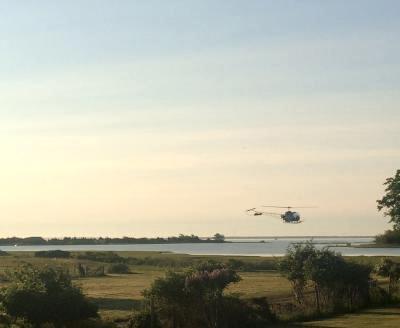Controversial Larvicide Remains in Mosquito Control Plan

The Suffolk County Legislature approved a 2018 vector control plan on Tuesday that includes use of methoprene, a mosquito larvicide, but also acknowledges a pilot program launched this year at Accabonac Harbor that is intended to reduce and possibly eliminate the pesticide’s use.
The Legislature passed the 2018 plan by a 17-to-1 vote, a disappointment to activists who insist that methoprene is harmful to nontarget species including lobsters and crabs. While county officials say it is safe, the East Hampton Town Board and the town trustees have long opposed its use on wetlands under their jurisdiction. In the summer months, the county’s Division of Vector Control typically conducts a blanket application of methoprene via helicopters flying at low altitude over Accabonac Harbor, Napeague, and Beach Hampton in Amagansett.
But language added to the 2018 work plan marks a step toward its reduction and a more finely targeted application, rather than blanketing an area. “A cooperative project with the Town of East Hampton and the Nature Conservancy is underway to map mosquito breeding activity in Accabonac Harbor with the potential goals of pesticide reduction and preliminary designing for a wetlands restoration project,” it reads, describing the project in which interns from Stony Brook University identified mosquito breeding “hotspots” that could be more precisely targeted. These were logged by GPS, compiled, and characterized by location and level of activity. “Using the data, aerial treatment zones will be remapped, allowing for reduced pesticide use and for planning of wetland restoration actions,” according to the plan. The program is to serve as a guide for the development of similar programs at other marshland systems.
“It’s incremental change,” Legislator Bridget Fleming, who represents the Second Legislative District, said yesterday. “I know some people feel frustrated that there is not an outright ban on methoprene, but I continue to have as a goal the reduction and elimination of pesticide spraying to the extent possible and this is moving in that direction, so I was happy to support it.”
Sarah Anker, of the Sixth District, cast the lone dissenting vote.
“I was urged by some advocates to simply cast a no vote,” Ms. Fleming said, “but I felt it very important to recognize the commitment of the new director” of the county’s Division of Vector Control, Tom Iwanejko, “to reducing pesticides. That’s why even though I would love to see it go further, I want to maintain that relationship, and continue to look for opportunities to work cooperatively within a super-tight budget by bringing in the Nature Conservancy, the town trustees, and whomever else might be appropriate to assist the vector control program continue to move in the direction of reduction and elimination of chemical pesticides.”
On Monday, Kevin McAllister, the founder of the environmental advocacy group Defend H2O, repeated his call for restrictions on pesticide use in tidal wetlands. In a letter to County Executive Steve Bellone, presiding officer DuWayne Gregory, and members of the Legislature, he specifically asked that methoprene application be curtailed. Methoprene, he wrote, “is highly toxic to some species of freshwater, estuarine, and marine invertebrates.” Further, he wrote, arthropod-borne disease does not exist in larval-stage mosquitoes, and salt marsh mosquitoes do not transmit West Nile virus.
Connecticut banned methoprene’s use in coastal areas in 2013, New York City restricted its use near Jamaica Bay in 2001, and Rhode Island has restricted its use adjacent to Narragansett Bay and Long Island Sound, Mr. McAllister reminded the county officials. Each of those jurisdictions, he wrote, relies on Bti, a biological agent that is believed to be harmless to nontarget species.
“If there was a suspension of methoprene use,” Mr. McAllister said on Tuesday, “maybe there could be a policy where if things get completely out of hand with infestations, we relax the restriction and deal with it.” The pesticide’s continued use, he said, is about quality of life rather than public health. “At least let’s get through a trial here,” he said of a suspension of methoprene use, “instead of defending it at all costs.”
The county reported seven cases of West Nile virus, two of which were fatal, in 2017. The seven were in the Towns of Brookhaven, Smithtown, Islip, and Babylon. As of September, 119 mosquito samples in the county tested positive for West Nile virus and four tested positive for eastern equine encephalitis virus.
In another change to the 2018 work plan, the Department of Public Works will increase its focus on controlling ticks and other arthropods that are vectors for human disease, Ms. Fleming said. “From my perspective, that’s a really important change because it’s been, and continues to be, my goal to shift some of the focus of the vector control program from mosquito control to what’s really critical in our district and the South Fork, which is tick-borne illnesses.”
